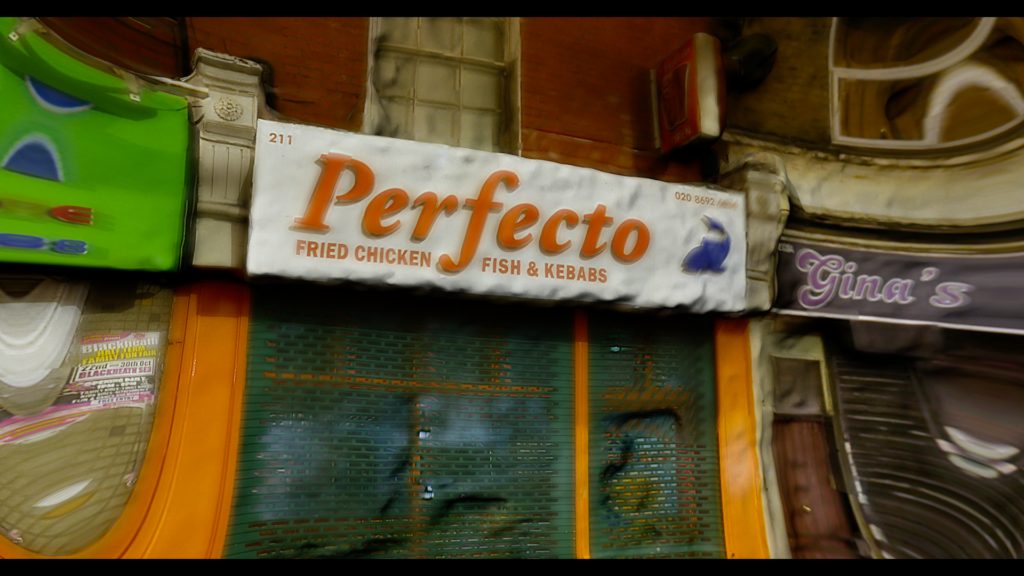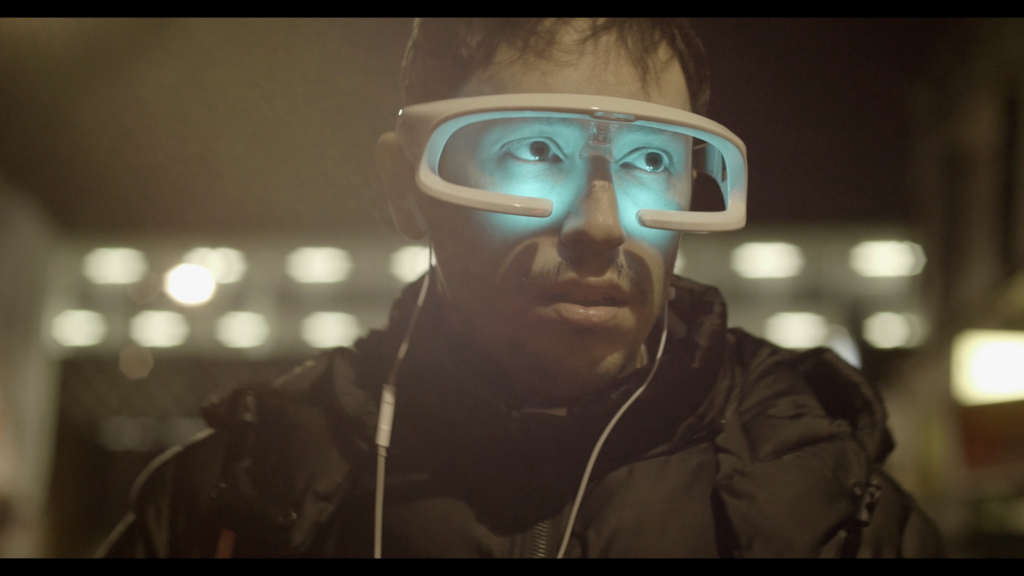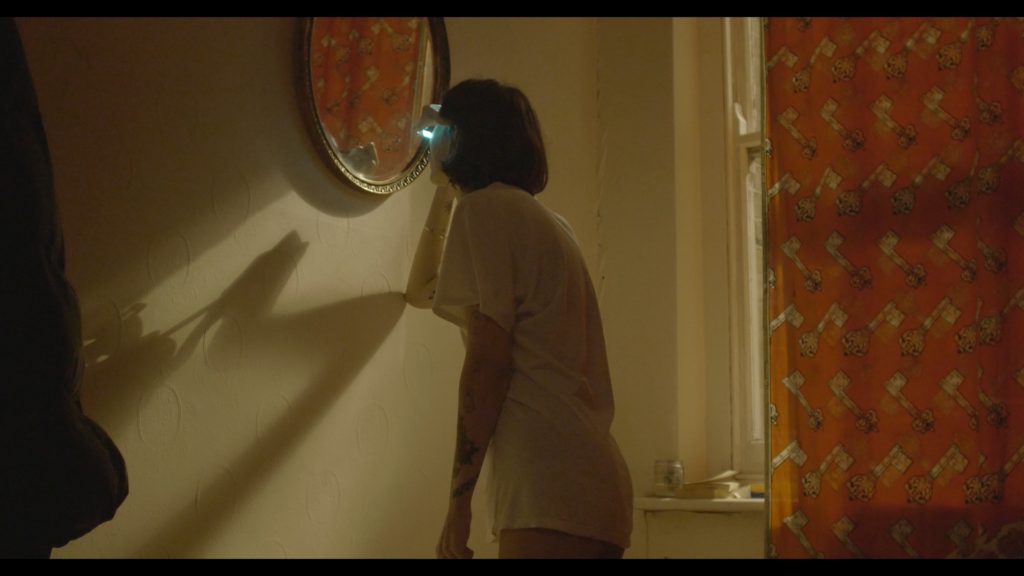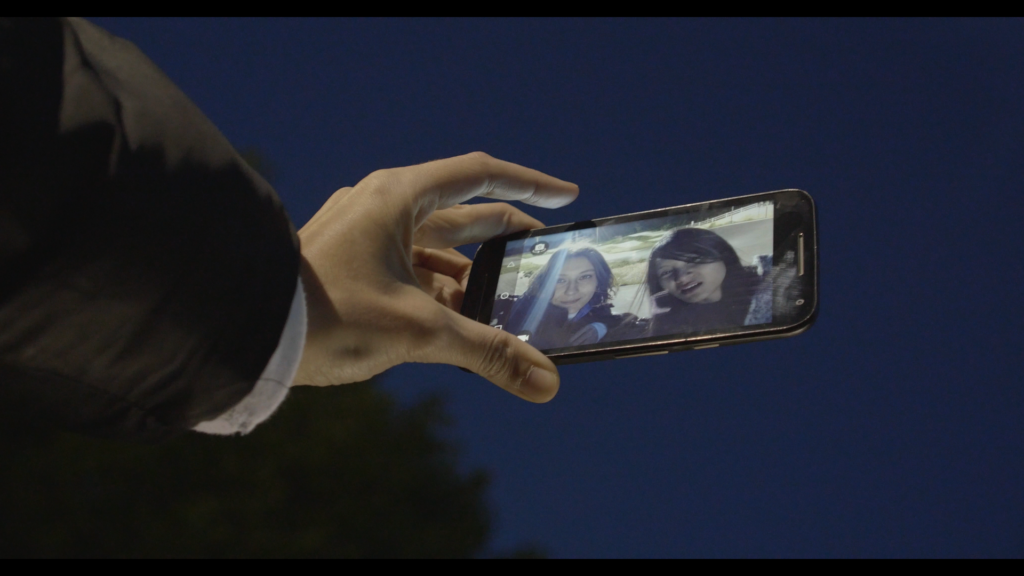“Because it’s a nice title, no?” Martin Kohout jokes when I ask him the very basic question of where the name for his latest work comes from. “Sometimes people think if they understand the title, they will understand the piece and I think that would be very misleading.” The Berlin-based, Czech artist has just completed Slides, a 20-minute video set in the strange but familiar streets and spaces of London. Awarded the Jindřich Chalupecký Award late last year, the softly surreal film lingers listlessly in the warped microcosm of a 24-hour city, inspired by the notion of night shifts and the physical and psychological toll it takes on the people who work them.

“Originally, I thought that I would be able to do more of a documentary-style project,” Kohout says, his disembodied voice coming through the graded blue and dirty-pink background of a Skype window; a circular thumbnail of an empty chair standing in for his face. “But then that became really complicated because we would never be allowed to enter workplaces that first said, ‘yeah, yeah, this sounds great, you can come to our testing facility for the nuclear reactor where we’ll simulate a nightshift.’ And I was like, ‘this is crazy, this is going to be amazing’, however of all the places we wanted to film, none were possible. So that’s why the film is actually totally fiction and in the end is not about night shifts, really. It’s more about how people communicate when there’s some sort of barrier between them.”
It’s midday for Kohout, late-evening for me. We’re sat eight hours apart and across continents; myself in the Southern Hemisphere of Australia, summer; him in the Northern Hemisphere of England, winter. Kohout has taken time out from installing his Daylight Management exhibition from London’s Auto Italia – opening January 13 and running to March 18 – to talk. I’m almost ready to go to bed. Ordinarily, I would prefer to conduct an interview in person and in the same timezone but the remoteness of our encounter is relevant to a film and a project that the press release refers to as being concerned with “the social impact of staying connected to friends and loved ones who exist at opposite ends of the day.”

Mercurial and discombobulated, Slides features three main characters, played by London-based Turkish artists Bora Akıncıtürk and Aslı Özdemir, and Vietnamese-born German artist Sung Tieu who seem to never sleep and spend most of their time with their smartphones. Akıncıtürk and Özdemir drift through life on converse work schedules and communicate via audio message, vaping and telling each other fabulous stories that draw on the technologies and social networks that affect them: “And then one day, can you imagine it? You’d be browsing pictures online and then you see these strangers making duck faces on your own sofa. And of course you think it’s somewhere else and you even like the picture, yep. Hey Bora, tonnes of kisses, bye!”
Kareem Lotfy soundtracks Slides, setting the tone of eerie somnambulance that accompanies the characters’ movements through empty tube stations and buses, a BMX track, down a darkened street wearing a pair of light therapy glasses that simulate the sun for sufferers of jet lag. “The film is definitely inspired by my own experience of being in China in 2016,” Kohout says about his time spent on a two-month residency at I: project space in Beijing. “I was 11 hours ahead of Berlin and I was communicating with my girlfriend at the time, mostly by recording these voice messages. Walking around somewhere I would feel, ‘wow this is crazy, it’s really something I need to share’ and I would describe it in an audio message. In the film, this is like a detail but a lot of the time they speak to each other while making these audio messages. They say, ‘look!’ They tell the other person to look, which is of course nonsense, in a way, but somehow I feel like it does make sense, it’s not totally out of place. So the film is inspired by me having not only temporal distance but spatial distance between me and the person I want to be in touch with all the time.”

The imagined universe of Slides, though, is just one part of a broader and more consequential project called Night Shifts, which includes the Daylight Management exhibition, a publication called Night Shifter, and a roundtable discussion hosted by the Southern and Eastern Trade Union Congress (SERTUC). The latter event brought together other unions, scientists and industry representatives to discuss current workplace policies around shift work. Originally proposed as a documentary film funded by the Wellcome Trust and produced by Caroline Heron of AQNB Productions, Kohout planned to interview and examine the lives of people working night shifts from their places of employment. It soon transpired, though, that those companies that had agreed to access a year earlier had never had any intention of allowing Kohout entry and the project took a sharp turn to the more abstract arena of a fictional tale of a slightly exaggerated present. As a result, the interviews Kohout had filmed of the shift workers and sleep scientists he’d contacted independently during his research have been compiled and edited into a 30-minute video that will screen as part of the Daylight Management event programme.
“I had nightshift jobs, either in bars or other places, and a lot of the time as a freelancer I would be working through the night but the experience of that is still very far from what it’s like when you work for five consecutive nights,” says Kohout about the distinction between the experience of the artist-characters in Slides, and those of contracted shift workers. “It was always one of the questions I asked all the people I interviewed: ‘how would you describe this experience to somebody who thinks of tiredness mainly based on physical exhaustion?’” Kohout elaborates. “Most of the time, the people I interviewed said ‘there is no way you can explain it, there is no way you could describe it, or understand it.’ From their description it’s much more a ‘zombie-mode,’ where your body is physically shutting down and after three or four days working a night shift you’re also mentally so exhausted that it’s not the exhaustion we know after one night shift, or a day of sport. I was interested in trying to figure that out but that was also one of the findings of my research, that it’s very hard to to describe, or rather impossible.”

For anyone familiar with Kohout or his work, he isn’t one for simplification. Active since graduating Frankfurt’s Städelschule in 2013 (film school before that) the Prague-born artist has been making highly conceptual work, with a strong individual aesthetic that’s nonetheless hard to pinpoint. His execution is very deliberate, and his ideas are particularly detailed. They’re backed by such a breadth of knowledge and information that they refuse the impulse to give simple answers, generalisations, for what are very complex systems. “I am often interested in these things that we consider rules or structures that we follow and so on, and then definitely the tactics that people develop to operate within them, or derail them, detour, turn them upside down or against themselves,” says Kohout about the concerns of his practice-at-large. “For a long time I used to say that my work is focused on the habits that come with technologies and how these habits reshape our perception of both the technologies that came with it and and the habits that they introduced. Now, the idea of dating, for example, is so different and the whole idea of relationships for the younger generation – not mine, necessarily, but the younger one – is people feel like if their relationship doesn’t work, you just go and look for someone else because you can just swipe some more and you have so many options. And when Facebook was introduced and people would get used to sending friend requests to each other, I felt like even in real life people started having a different attitude when being introduced to other people and introducing themselves. Those were effects that would not be immediately there but they would reshape the thing which they were supposed to update or build on top so it was this interesting loop.”
That interest carries into larger structures too, with the actions and behaviour of corporate entities shifting the foundations of what is legal or acceptable, “For example, you look at our attitudes to privacy, a lot of these things are defined backwards. We get used to a breach of our privacy because we see the other things that it brings us and we’re suddenly fine with it, that all these companies take all this data. If someone was like, ‘you know how bad it is, we should make it illegal but as a side-effect you will lose all this functionality,’ people are like, ‘no, I prefer to keep this functionality and redefine the law,’ or redefine legislation, or redefine the rules so that this is actually possible to continue.”

The themes of the effects of existing capital systems on the individual and how that individual navigates them has been of ongoing concern for Kohout. His elaborate engagement with these subjects, often splashed with an absurdist touch, emerges in a broad portfolio, that includes exploring the effects of SAD lamps on Seasonal Affective Disorder during a commission for corporate consulting firm McKinsey & Company. It then informed his 5006 years of daylight and silent adaptation exhibition at Exile in 2014. He also ran the third-longest road tunnel in the world as part of his ‘Gotthard‘ performance and dragged a smartphone across a range of indiscernible tourist hot spots in ‘Sjezd.’ Even more pertinently, Kohout examined the exploitative structural status quo of a post-Fordist economy in a book called Sleep Cures Sleepiness, edited by himself and published via his own TLTRPreß. “Machines can work around the clock at the same pace, speed and give the same output, sort of like a flat performance, where, as I see it, there are no peaks,” he says, mapping our relationship to work in the context of global corporations, as facilitated through digital communication. “While humans have these various peaks and lows as a result of metabolism, your brain is more active in this part during the night, and another part of your brain in another part of the day. Your stomach is active in some parts of the day and trying to rest in other parts. Your whole performance is also not flat, it’s changing, it’s organic. Then there’s the clash of circadian rhythm with these machinic expectations; that’s what has interested me for a long time and that’s why sleep and so on is such a big part of my interests.”
This is where the experience of a night shift worker and the strains of modern life on the mind and body of a human more generally, converge in Slides. In one scene, Akıncıtürk is seen and heard walking through London’s Deptford High Street describing how local businesses adapt to a constantly shifting market as if they were smartphone apps: “The shops around here, look at them, it’s not what it says on the tin. It’s all because the shopkeepers are following recommendations from various trading apps and they jump on to the next hot topic, as long as it’s cheap enough to exchange the stock and they also track their neighbours, to figure out what they’re buying next. So remember, people are pretty whimsical but at the same time they’ve got habits.”

One might expect an exploration into the networked infrastructures that govern and affect our relationships to be a bleak and dystopian one but Kohout is more objective. “I don’t think that in the film the technologies they use are making them more alien to one another. I think it’s clear that it’s some sort of other structure, most likely the schedule of their work. So they use these technologies to actually get closer but then when Bora, for example, talks to Siri and at the end of the conversation he says, ‘Siri, I just want to sleep,’ and Siri says, ‘Bora, listen to me, put down the iPhone and take a nap, I will wait here.’ You realise this is the creepiest thing the phone could ever say but it’s trying to be nice.” Kohout says with a chuckle. “There is something that is so natural for us that we are no longer looking at it in this grand scheme of ‘they’re all bad or they’re all good.’ We take every individual one of these technologies in context and see what we can get from them. I feel like the way that people imagine the world around them is definitely shaped by the attention span they have. For me, it’s when the characters in the film tell these stories, some people say, it’s like speculative fiction of the near future but I think it could very much be a film about ‘right now’ because what they’re describing more or less exists but they just exaggerate it, they just push it to the limit.”
At the end of Slides, Özdemir is heard singing a sweet song of loneliness. The Turkish version of Petula Clark’s ‘This is My Song,’ written by Charlie Chaplin in the 60s, resonates through the artist’s unsteady a capella, sung to an empty estate at night time while the translated lyrics appear as subtitles on screen:
“This is my song,/ I sing it for you,/ no one can sing it,/ as emotional as I do,/ where are you now?,/ where is your sweet voice.”
The words are slightly different from the original, also sadder.**













